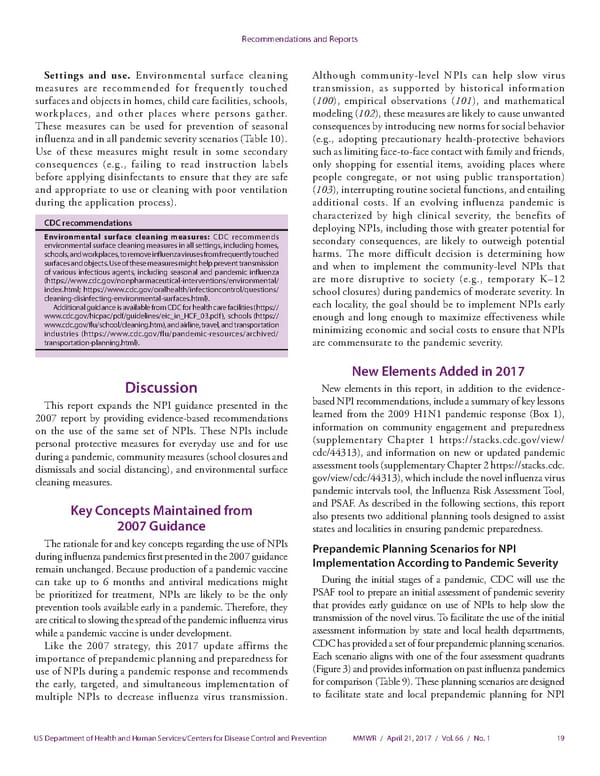Recommendations and Reports Settings and use. Environmental surface cleaning Although community-level NPIs can help slow virus measures are recommended for frequently touched transmission, as supported by historical information surfaces and objects in homes, child care facilities, schools, (100), empirical observations (101), and mathematical workplaces, and other places where persons gather. modeling (102), these measures are likely to cause unwanted These measures can be used for prevention of seasonal consequences by introducing new norms for social behavior influenza and in all pandemic severity scenarios (Table 10). (e.g., adopting precautionary health-protective behaviors Use of these measures might result in some secondary such as limiting face-to-face contact with family and friends, consequences (e.g., failing to read instruction labels only shopping for essential items, avoiding places where before applying disinfectants to ensure that they are safe people congregate, or not using public transportation) and appropriate to use or cleaning with poor ventilation (103), interrupting routine societal functions, and entailing during the application process). additional costs. If an evolving influenza pandemic is characterized by high clinical severity, the benefits of CDC recommendations deploying NPIs, including those with greater potential for Environmental surface cleaning measures: CDC recommends secondary consequences, are likely to outweigh potential environmental surface cleaning measures in all settings, including homes, schools, and workplaces, to remove influenza viruses from frequently touched harms. The more difficult decision is determining how surfaces and objects. Use of these measures might help prevent transmission and when to implement the community-level NPIs that of various infectious agents, including seasonal and pandemic influenza (https://www.cdc.gov/nonpharmaceutical-interventions/environmental/ are more disruptive to society (e.g., temporary K–12 index.html; https://www.cdc.gov/oralhealth/infectioncontrol/questions/ school closures) during pandemics of moderate severity. In cleaning-disinfecting-environmental-surfaces.html). each locality, the goal should be to implement NPIs early Additional guidance is available from CDC for health care facilities (https:// www.cdc.gov/hicpac/pdf/guidelines/eic_in_HCF_03.pdf), schools (https:// enough and long enough to maximize effectiveness while www.cdc.gov/flu/school/cleaning.htm), and airline, travel, and transportation minimizing economic and social costs to ensure that NPIs industries (https://www.cdc.gov/flu/pandemic-resources/archived/ transportation-planning.html). are commensurate to the pandemic severity. New Elements Added in 2017 Discussion New elements in this report, in addition to the evidence- This report expands the NPI guidance presented in the based NPI recommendations, include a summary of key lessons 2007 report by providing evidence-based recommendations learned from the 2009 H1N1 pandemic response (Box 1), on the use of the same set of NPIs. These NPIs include information on community engagement and preparedness personal protective measures for everyday use and for use (supplementary Chapter 1 https://stacks.cdc.gov/view/ during a pandemic, community measures (school closures and cdc/44313), and information on new or updated pandemic dismissals and social distancing), and environmental surface assessment tools (supplementary Chapter 2 https://stacks.cdc. cleaning measures. gov/view/cdc/44313), which include the novel influenza virus pandemic intervals tool, the Influenza Risk Assessment Tool, Key Concepts Maintained from and PSAF. As described in the following sections, this report also presents two additional planning tools designed to assist 2007 Guidance states and localities in ensuring pandemic preparedness. The rationale for and key concepts regarding the use of NPIs Prepandemic Planning Scenarios for NPI during influenza pandemics first presented in the 2007 guidance Implementation According to Pandemic Severity remain unchanged. Because production of a pandemic vaccine can take up to 6 months and antiviral medications might During the initial stages of a pandemic, CDC will use the be prioritized for treatment, NPIs are likely to be the only PSAF tool to prepare an initial assessment of pandemic severity prevention tools available early in a pandemic. Therefore, they that provides early guidance on use of NPIs to help slow the are critical to slowing the spread of the pandemic influenza virus transmission of the novel virus. To facilitate the use of the initial while a pandemic vaccine is under development. assessment information by state and local health departments, Like the 2007 strategy, this 2017 update affirms the CDC has provided a set of four prepandemic planning scenarios. importance of prepandemic planning and preparedness for Each scenario aligns with one of the four assessment quadrants use of NPIs during a pandemic response and recommends (Figure 3) and provides information on past influenza pandemics the early, targeted, and simultaneous implementation of for comparison (Table 9). These planning scenarios are designed multiple NPIs to decrease influenza virus transmission. to facilitate state and local prepandemic planning for NPI US Department of Health and Human Services/Centers for Disease Control and Prevention MMWR / April 21, 2017 / Vol. 66 / No. 1 19
 Community Mitigation Guidelines to Prevent Pandemic Influenza Page 20 Page 22
Community Mitigation Guidelines to Prevent Pandemic Influenza Page 20 Page 22